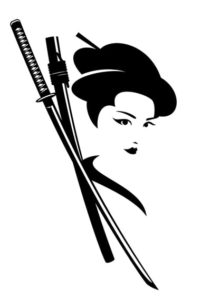Building ninja characters for DnD 5e can take many different forms, from the obvious rogue to the less obvious bard. These campaigns can be filled with intrigue, espionage and mystery, sprinkled with martial arts showdowns. Therefore, creating an entire party of ninjas can offer a unique playing experience with tons of diverse skills and strategies.
I was feeling somewhat inspired after watching Naruto Shippuden… again. The realization hit me that ninja come in all shapes and sizes and looks. This show does such interesting character design that could absolutely come to life as a DnD 5e campaign. Also, characters may want to multiclass with wizard or druid to gain access to elemental spellcasting. However, this list will cut to the core of the ninja trope.
Dungeons and Dragons 5e offers several character options that fit a ninja, including:
- Rogue Assassin
- Rogue Scout
- Phantom
- Ranger Gloom Stalker
- Ranger Hunter
- Bard: College of Swords
- Bard: College of Whispers
- Monk: Way of Shadow
- Monk: Way of the Kensai
Rogue Builds
Naturally, the first class with ninja potential is the rogue. One could argue that this should be the end of the article, but there’s so much range in what a ninja could be. We can’t be content with slapping on a black mask and picking the most obvious choice.
That being said, the rogue is obviously a good choice. This class can handle any type of slender blade, ranging from longsword to rapiers to daggers. They can also handle implements like hand crossbows and thieves’ tools. For me, this means open room for all the ninja weapons and gadgets I want. As far as proficient skills go, I’m choosing Acrobatics, Stealth, Perception and Sleight of Hand. If I’m going for a traditional ninja, I’m going to be an acrobatic assassin.
Rogue Assassin
Assassins lean even further into the classic ninja vibe, with ambush tactics and deadly damage output. This is no jewel thief, no cunning agent of espionage. We’re talking about a full-fledged serial killer for hire. This ninja is an infiltration expert with several deadly tricks at hand. My first thought is to play this classic tactician as Drow, utilizing the Dexterity and Charisma bonus
Picking this archetype immediately grants me proficiency with disguise kit and poisoners kit. Both of these crafts are highly ninja in nature. There exist endless possibilities. I like the concept of crafting my own poisons and finding ingredients along my adventure—it satisfies my creative urge as a complex task with a high payoff.
Assassins also learn—wait for it—Assassinate. This two-part combo offers my character advantage on enemies who haven’t attacked yet and gives me a critical attack roll against surprised enemies. Couple this with Sneak Attack received at level 1, and we’re looking at an extra 1d6 damage against anyone who’s too slow. Plus, this increases to 2d6, 3d6 and further as I level.
Check out my Rogue Assassin Guide Here.
Rogue Phantom
Rogue phantoms tap into an ability to commune with the dead, falling deep into shadowy realms of knowledge and ability. Gaining information from the spirit world, this character can gain help with almost any task. Naturally, I’ll gain abilities that deal ghostly damage, tokens with special ghostly abilities and even the ability to phase through walls.
Introduced in Tasha’s Cauldron of Everything, phantoms begin their journey with Whispers of the Dead and Wails from the Grave. Whispers of the Dead gives me proficiency in a tool or Skill that I’m lacking. However, I’ll need to rest in between uses. Also, Wails from the Grave uses ghostly attackers to deal damage to second enemy when I use the Sneak Attack feature. Now, the second target takes half as much Sneak Attack damage as well.
The Ghost Walk ability comes at level 13, making for expert infiltration. Now, my invisible friends or disguise-making allies get to be jealous of my incorporeal form.
Check out my complete Rogue Phantom build Here.
Rogue Scout
If I took a rogue and dipped it in ranger sauce, this is probably what I would end up with. Not to mention, this class has Naruto written all over it—looking all cool with my ninja backpack. In the way ninja must accomplish missions across the cotenant in Naruto’s world, this character is a specialist. He or she is a survival expert and a battlefield infiltrator.
Scouts are often used in similar ways to the ranger, sent ahead to scope out potential enemies or traps. As a rogue, I’ll gain advantage on stealth attacks against unsuspecting guards. On top of this perk, I’ll gain the Skirmisher and Survivalist abilities as soon as I take this path.
Skirmisher allows me to move half my speed as a reaction when an enemy ends its turn within 5 feet of me, and it doesn’t trigger opportunity attacks against me. This kind of maneuverability is a tremendous help in not getting caught. Nobody is going to be able to get close.
Survivalist gives me proficiency in the Nature and Survival skills. Oh yeah, and the proficiency check is doubled. I might actually end up with better checks than rangers in these skills, especially in the Intelligence-based Nature.
Ranger Builds
Nice segue to my ninja ranger builds, am I right?
This class has its own unique style of ninja potential. Most notably in my mind, the use of animal companions to achieve missions is cool. Even skills like Animal Handling, or spells like animal friendship, beast bond and animal messenger, offer unique abilities for ninja-style gameplay. A befriended squirrel could gather intel in places unreachable to larger intruders.
Or, I could focus on spells and skills that align more with a stealth warrior. Classic ranger spells such as hunter’s mark, fog cloud and pass without trace are all on point for ninja characters. Utilizing a katana with the Duelist Fighting Style, my high Dex bonus, and a damage-dealing magic effect, I’ll be bad.
Ranger Hunter
Hunters make for strong hired muscle with the ability to both handle minions and big monsters alike. Add a katana, Duelist fighting style, hunter’s mark, Colossus Slayer and Horde Breaker together, and we have a Dexterous character with high damage output. Duelist Fighting Style will add +2 to damage with a one-handed weapon and Colossus Slayer adds an extra 1d8 damage to injured foes. Finally, add the extra 1d6 damage from hunter’s mark.
As usual, I would pick a wood elf race for this character. The extra elven abilities plus the modified Dexterity and Wisdom score make this race the king of rangers. They can combine ranger spells like fog cloud with their elven ability to hide in nature. Plus… you know… themes.
Ranger Gloom Stalker
Like the scout, gloom stalkers toe the line between ranger and rogue. I like to think of it as a Drow ranger in the Underdark or leopard Tabaxi as an ambush specialist in the deep jungle. Their abilities grant them magical disguises, superior dark vision and tricky tactics, all of which are shinobi gold.
These specialized hunters gain spells that relate to their theme. At level 3, gloom stalkers learn disguise self, and level 5 adds rope trick. Disguise self is pretty self-explanatory. Rope trick is a bonkers spell with a rope and pocket dimension for storage or temporary body transfers. Check out my Gloom Stalker Character Build article for more details about these spells.
The Dread Ambusher and Umbral Sight abilities offer heightened ninja play as well. Dread Ambusher offers an initiative bonus equal to my Wisdom modifier. Then, my walking speed increases by 10 feet when this ability is activated, giving me an extra attack option as well as an extra 1d8 damage for that attack. Umbral Sight gives me darkvision of 60 feet (or 30 extra feet if I already have darkvision). On top of that, I remain invisible to creatures using darkvision to see me.
These benefits could make for the perfect ninja-hunting ninja.
Bard Builds
Bards make for interesting sabotage characters, with helpful features like Bardic Inspiration and Jack of All Trades. However, they can be surprisingly effective in a deadly ninja campaign.
A musician plays his instrument in the marketplace, wide-brim hat covering his face. He is a master of hiding in plain sight, waiting for an opportunity to strike his target unexpectedly. I couldn’t help but bring in something a little different.
Bard spells are psychic in nature, manipulating the minds of others. Illusion spells and psychic damage make for effective stealth and ambush tactics. Plus, imagine hiding your blade in the neck of the bard’s instrument. And with proficiency bonuses all around, the bard is a master problem solver in the heat of the story.
Bard: College of Swords
Introduced in Xanathar’s Guide to Everything, the College of Swords created the sword fighting specialist of the bard class.  This could mean a swashbuckling fencer in certain types of games, but for ninjas we’ll use a katana with the Finesse property.
This could mean a swashbuckling fencer in certain types of games, but for ninjas we’ll use a katana with the Finesse property.
On picking this college, I’ll receive a few new proficiencies (medium armor and the scimitar) and a fighting style. The choices of fighting style are between Dueling and Two-Weapon Fighting. Either of these choices are cool. I prefer Dueling, to add +2 to my damage rolls, but an opportunity to be the two-sword ninja is also tempting.
Then comes the Blade Flourish. Using my Bardic Inspiration die, I can activate 3 different blade flourishes: Defensive Flourish, Slashing Flourish and Mobile Flourish.
Defensive Flourish allows me to expend a Bardic Inspiration die to add extra damage to the target I hit. Then, I get to add that roll to my AC for one turn. This is crazy because I could potentially receive a +6 AC bonus after doing that much extra damage.
Slashing Flourish also adds 1d6 extra damage. However, the additional effect is to hit another target within 5 feet of the first.
Mobile Flourish is a driving attack that pushes the enemy back. Once again, add the 1d6 Bardic Inspiration to damage. Then, this attack pushes the target 5 + 1d6 feet away, then allows me to move in reaction to a space 5 feet away from my opponent. Think of it as taking control of the fight, pushing the enemy toward a hidden ally or off a cliff.
Check out my Bard College of Swords build Here.
Bard: College of Whispers
A Bard College of Whispers leans more toward the psychic magic side of bards, but with a few extra elements particular to ninja.
Psychic Blades adds a fat boost to damage rolls equal to 2d6 starting out. Only use this once per round. As I mentioned, bards have a way of getting close to important people. This gives them a unique angle to attack from. Add in the extra psychic damage, and we have a gnarly psychic assassin. Words of Terror comes along at level 3 as well, adding the ability to paralyze foes with fear.
Level 6 really turns up the hidden assassin angle with Mantle of Whispers. This ability allows me to capture fallen enemies’ shadows in order to disguise myself as them later. I mean, shadow magic is pretty high up on the ninja theme scale.
Monk Builds
Monk builds can utilize Martial Arts and supreme maneuverability to make a unique ninja based in martial prowess.
Originally, I wasn’t going to include monks. Yeah, they and ninja are both modeled after East Asian martial arts warriors, but one doesn’t equal the other. Ninjas are more than karate guys in masks. They have many aspects that often are overlooked, such as tactical prowess and clever intelligence.
That being said, this article was inspired by Naruto, and Rock Lee’s ninja way should be included. Way of the Open Hand and Way of the Drunken Master would be awesome options in this kind of story. They could be unarmed martial arts specialists, monks in the land of samurai and shinobi.
Monk Way of Shadow
After learning Martial Arts and mastering Unarmored Defense and Unarmored Movement, the Way of Shadow is an obvious next step as a ninja.
Way of Shadow grants my monk access to shadowy spells using Ki points. Now, I have access to darkness, darkvision, pass without trace and silence by spending 2 Ki points. Plus, I gain minor illusion as a cantrip.
Then, I learn Shadow Step at level 6, giving me the ability to teleport up to 60 feet away in darkness. I’ll need to find an area of darkness or dim light, then teleport to another area of dim light or darkness. Therefore, I can add an insane amount of maneuverability to an already fast character. Plus, I’ll gain advantage on my next attack as I surprise my enemy.
For my complete Monk Way of Shadow Guide, Click Here.
Monk Way of the Kensei
Holy moly, we can make a Ninja Turtle. Ninja Tortle, that is.
It turns out, Tortle’s make killer monks. The monk’s Unarmored Movement mixed with the Tortle’s Natural Armor and Shell Defense is just too perfect. So, even without the Ninja Turtle theme, this class would be a blast to play.
So, let’s get into Ninja Turtle territory.
The Path of the Kensei is a path that hones a specific (or 2) weapon skillset to perfection. As a bonus skill, choose either painting or calligraphy. These focused and honed character traits are TMNT adjacent. The turtle brothers all specialize in their weapon of choice and are each named after Renaissance painters. Once again, too perfect. For game purposes, this goes for melee and ranged weapons. Maybe a shuriken could be used for range, keeping the classic Ninja Turtle weapons as my melee choice.
As far as combat goes, the Path of the Kensei offers 6 different abilities: Kensei Weapons, Agile Parry, Kensei’s Shot, Way of the Brush, Magic Kensei Weapons and Deft Strike.
Kensei Ability Breakdown:
Kensei Weapons offers my character 2 weapons, one ranged and one melee, to specialize in. This means I only use these two weapons because that’s the cost of the bonus effects. It’s kind of mystical like that. Oh, and they count as monk weapons even if they are a sword or longbow.
Agile Parry allows me to add +2 to my AC after making an unarmed strike. Meaning, that bonus attack I get for being a martial artist triggers this effect. As if I needed more defensive bonuses.
Kensei’s Shot adds an extra 1d4 damage to ranged attacks made with my Kensei weapon. Some may go ahead and use a longbow here, it would be a strong choice, but I’m a sucker for theme. I’ll probably pick shuriken for this weapon.
Way of the Brush gives proficiency with my choice of calligrapher’s supplies or painter’s supplies. It’s that whole honed hand vibe a weapon master would have. I’ll be an all-around artist.
Magic Kensei Weapons means the chosen blade or nunchaku or staff or sai counts as magical. There’s no added effect, just the ability to hit ghosts or ethereal creatures as if the weapon were silver.
Deft Strike is like a ki focused attack. Spend 1 ki point to cause the weapon to deal extra damage equal to the Martial Arts die.


